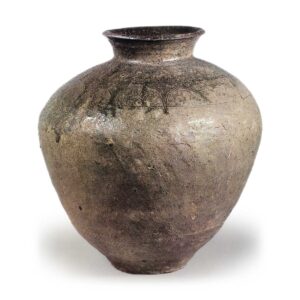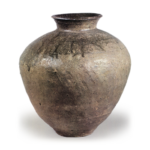
Excavated from Sutra Mound, Mount Kanukiyama, Kanuki-cho, Numazu-shi, Shizuoka
12th century
Height 42.2cm, mouth diameter 17.5cm, body diameter 39.8cm, bottom diameter 13.5cm
Tokyo National Museum
It was excavated in September 1918 from one of the sutra mounds on the southwestern plateau of Mt. It was a large flat bowl of 22 cm in diameter with a lid.
It is said that a large flat bowl of 22 cm in diameter was used as a lid.
The jar is made of coarse, sandy clay with a high iron content and many small black particles blown out on the surface. The body of the jar was formed by winding up the clay and was joined in three sections. The lower section shows traces of pounding by a mold, while the upper section shows traces of smoothing with clay. The neck of the bowl is turned outward, and the rim is thickened and beveled at an angle without being folded back, giving the bowl a triangular cross-section. The design consists of three parallel parallel lines of half-cut bamboo tubes on the shoulders, interspersed with double lines of upward-facing semicircular arcs. The design is more appropriate for a series of arcs than for a lotus petal design. Such a staggered pattern of interlocking arcs within horizontal lines is a pattern often applied to Atsumi-gama medium-sized vases, and there is no doubt that this vessel is a product of the Atsumi kiln in terms of both the clay, molding, and design. The strong fire caused cracks in the firing, and the half-surface of the shoulder is greatly distorted.








